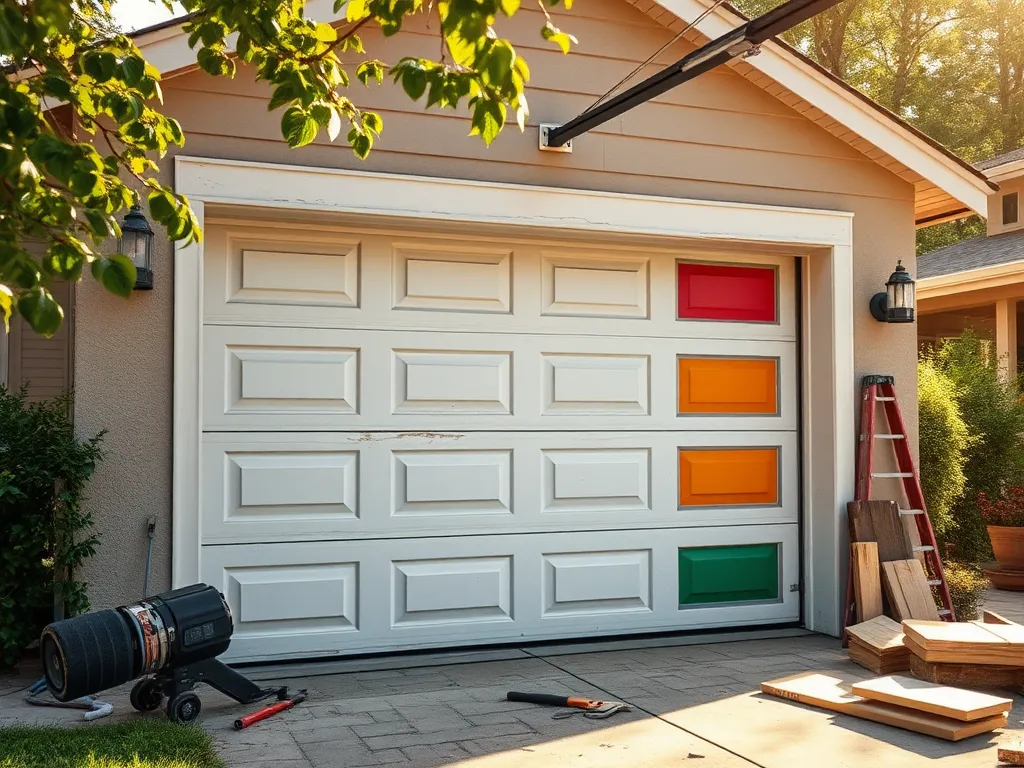Transforming Your Home: Retrofitting an Old Garage Door

Retrofitting an Old Garage Door: A Comprehensive Guide
Retrofitting an old garage door can breathe new life into your garage, enhancing its functionality and appearance while also providing cost savings compared to a full replacement. This process offers homeowners a chance to upgrade their existing doors without the expense and hassle of completely starting from scratch. Retrofitting an Old Garage Door not only maintains the structure's character but also adds modern features to improve energy efficiency, security, and aesthetics.
Homeowners seeking to improve their garage's efficiency can find a variety of garage door retrofit solutions that suit their needs.
The trend of retrofitting is gaining popularity as homeowners recognize the benefits of enhancing their existing garage doors instead of opting for a costly new installation. Retrofitting an Old Garage Door involves a careful assessment of the current condition and capabilities of the door, allowing for targeted upgrades that can achieve significant improvements in performance and style. This approach is not only financially savvy but also environmentally friendly, as it reduces waste and promotes the reuse of materials.
Implementing regular garage door lubrication techniques is key to ensuring your garage door operates smoothly and quietly.
As the needs and preferences of homeowners evolve, so does the technology surrounding garage doors. Retrofitting an Old Garage Door provides an opportunity to incorporate advancements that can enhance the user experience, such as improved insulation, advanced security features, and smart garage door openers. Homeowners can customize their garages to better fit their lifestyle while maintaining the unique charm of the original door.
Ultimately, the decision to retrofit an old garage door is about balancing practicality with personal taste. Whether you aim to boost your garage’s energy efficiency, improve security features, or just revamp its appearance, retrofitting offers various options to suit different preferences and budgets. This guide will explore the numerous benefits of retrofitting, the techniques involved, common challenges, necessary tools and materials, and tips for choosing between DIY and professional services.
In conclusion, retrofitting an old garage door stands as a wise investment for homeowners looking to upgrade their space. By enhancing the functionality, aesthetics, and safety of your garage door, you can create a more efficient and appealing structure that complements your home while saving money and resources.
If you're considering modernizing your old garage door, many options are available to enhance both functionality and style.
Benefits of Retrofitting an Old Garage Door
One of the primary benefits of retrofitting an old garage door is the cost savings when compared to replacing the door entirely. Replacing a garage door can be expensive due to the price of the new door itself as well as installation costs. By retrofitting, homeowners can significantly cut down on these expenses while still achieving a modernized look and better performance.
Improved energy efficiency and insulation are vital enhancements made possible by retrofitting. Adding insulation panels or upgrading to insulated doors can reduce energy costs by regulating temperatures better, especially in climates with extreme weather. This upgrade not only makes the garage a more functional space but also reduces the overall energy consumption of the home.
Exploring upgrading a vintage garage can add significant value to your home while preserving its historic charm.
Enhanced security features are another crucial advantage of retrofitting an old garage door. Incorporating new locks, security sensors, or smart technology can significantly improve the safety of your garage and home. Modern features provide better peace of mind and help deter intruders, making your property more secure than before.
For those tired of a noisy garage, silent garage door hardware upgrades can make a world of difference.
Retrofitting can also increase property value and curb appeal. A well-maintained and visually appealing garage door can make a substantial first impression and attract potential buyers. Upgrading aesthetics through retrofitting contributes to a more cohesive look for your home, making it more appealing to onlookers and potential purchasers.
Finally, retrofitting has environmental benefits by reusing materials instead of creating waste through complete replacement. Using existing structures not only conserves resources but also reduces the carbon footprint associated with manufacturing and transporting new garage doors. This eco-friendly approach aligns with growing preferences for sustainable living.
Techniques for Retrofitting Garage Doors
One effective technique for retrofitting garage doors is adding insulation panels for better thermal regulation. Insulation can significantly improve the thermal barrier of the garage, making it more comfortable year-round and potentially reducing energy bills.
Updating the garage door opener system is another component of retrofitting. Modern openers come equipped with enhanced safety features, smart technology, and quieter operations, which can transform the convenience and performance of your garage door.
Installing new weather stripping and seals is crucial for maintaining energy efficiency. These components help seal gaps, preventing drafts, moisture, and pests from entering the garage, thus fostering better climate control and protection for belongings stored inside.
Replacing old hardware and hinges can enhance both functionality and safety. Over time, hardware can wear down, leading to issues with door movement. By replacing these components, you ensure smooth operation while also reinforcing the door and its security features.
Lastly, repainting or refinishing the door allows for aesthetic updates. This simple measure can dramatically change the appearance of your garage, allowing you to match it with your home’s exterior and boost curb appeal without incurring significant costs.
Common Challenges in Retrofitting Garage Doors
One common challenge faced when retrofitting garage doors is ensuring compatibility with the existing structure and space. As older doors have unique dimensions and designs, it is crucial to measure and assess compatibility before beginning any retrofitting project.
Another challenge involves ensuring the door's weight is manageable for the opener. If the retrofitting process results in increased weight from insulation or new components, it may require an upgraded opener system that can handle the additional load.
Meeting local building codes and regulations can also present challenges when retrofitting. It's essential to research and comply with local guidelines to avoid penalties and ensure a safe and legal installation.
Assessing and addressing wear and damage is vital to a successful retrofit. Homeowners should carefully inspect the existing door for any significant issues, such as structural damage or rust, that could compromise the overall integrity of the retrofitted door.
Finding the right replacement parts for older models can be difficult, as many manufacturers no longer produce components for older doors. Homeowners may need to search specialized suppliers or consider using universal parts that can fit their existing door.
Tools and Materials Needed for Retrofitting
Essential tools for DIY retrofitting projects include a drill, screwdrivers, a measuring tape, a level, and safety goggles. These tools are necessary for removing old parts, making measurements, and installing new components combined with a strong focus on safety.
Recommended materials for insulation and sealing include foam insulation panels, weather stripping tape, and caulking. These materials will help seal gaps and improve the thermal efficiency of the garage door.
Upgrade options for garage door openers may include smart openers with Wi-Fi connectivity, battery backup systems, and quieter models. These upgrades improve the overall functionality of the garage door and enhance user experience.
Safety equipment is vital for a smooth installation process. This includes gloves, safety glasses, and work gloves, as these materials ensure protection during the retrofitting process while handling tools and materials.
Cost considerations for materials and tools can vary greatly. Homeowners should create a budget that accounts for both materials and necessary tools, considering whether to rent or purchase them for the retrofitting project.
DIY vs. Professional Retrofitting Services
Advantages of DIY retrofitting projects include cost savings, customization options, and the satisfaction of completing a project independently. Homeowners can choose to work at their own pace, selecting upgrades that fit their specific needs without hiring external help.
However, there are times when it may be beneficial to consider hiring a professional. If the project requires complex modifications, specialized knowledge, or poses safety concerns, enlisting a professional can ensure a safer and more reliable outcome.
Cost comparison between DIY and professional services varies significantly, as hiring a contractor typically incurs labor costs in addition to materials. Homeowners should evaluate their expertise and comfort level with specific tasks to determine the most cost-effective option for their project.
When choosing a reliable contractor, it's essential to check for credentials, reviews, and references. Obtaining multiple quotes and assessing the contractor’s experience with retrofitting projects can help ensure a successful outcome.
Finally, effective communication with professionals is key to a smooth retrofitting process. Homeowners should clearly express their goals and preferences, ask questions, and remain engaged throughout the project to ensure alignment and satisfaction with the end result.
